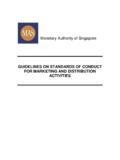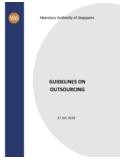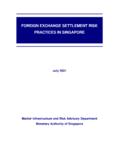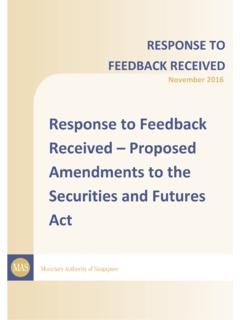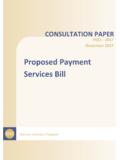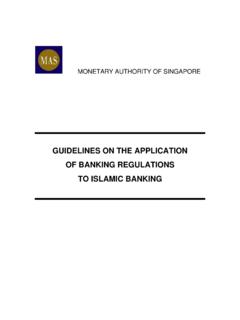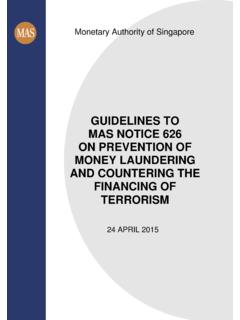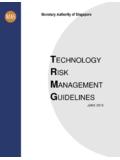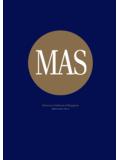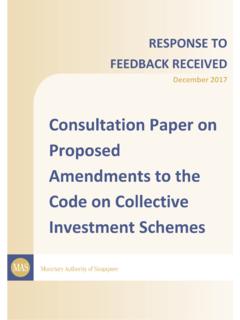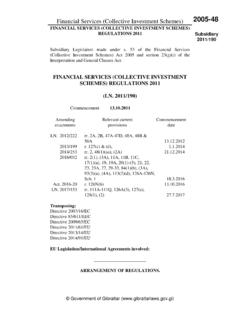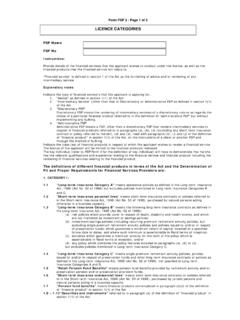Transcription of Code on Collective Investment Schemes
1 code on Collective Investment Schemes code on Collective Investment Schemes TABLE OF CONTENTS Chapter Page Preamble 1 1 Interpretation 2 AUTHORISED Schemes 2 The Trustee 4 3 The Manager 6 4 The Scheme 14 5 Accounts and Reports 16 6 Dealing and Valuation 18 7 Breaches 22 RECOGNISED Schemes 8 Assets under Management 23 9 Recognised Schemes and Authorised Schemes which Feed into an Underlying Scheme 24 10 Schemes Offered Under the ASEAN CIS Framework 25 PART I APPENDIX 1 Investment : Core Requirements 28 ANNEX 1A Illustration on benchmark limit 47 ANNEX 1B Alternative approach for calculating financial derivative exposure 48 APPENDIX 2 Investment : Money Market Funds 52 APPENDIX 3 Investment : Hedge Funds 57 APPENDIX 4 Investment : Capital Guaranteed Funds 64 APPENDIX 5 Investment : Index Funds 67 PART II APPENDIX 6 Investment : Property Funds 72 code on Collective Investment Schemes Page 1 PREAMBLE The code on Collective Investment Schemes ( code ) is issued by the Monetary Authority of Singapore (the Authority ) pursuant to section 321 of the Securities and Futures Act (Cap.)
2 289) ( SFA ). The code sets out the best practices on management, operation and marketing of Schemes that managers and approved trustees are expected to observe. The code is non-statutory in nature. A failure by any person to comply with any requirement in this code will not of itself render that person liable to criminal proceedings although any such failure may, in any proceedings whether civil or criminal, be relied upon by any party to the proceedings as tending to establish or to negate any liability which is in question in the proceedings. A breach of this code by the responsible person of a scheme may be taken into account by the Authority in determining whether to revoke or suspend the authorisation or recognition of the scheme under section 286 and 287 of the SFA respectively or to refuse to authorise or recognise new Schemes proposed to be offered by the same responsible person.
3 Similarly, a breach of this code by a trustee may be taken into account by the Authority in determining whether to revoke approval granted under section 289 of the SFA or to prohibit the trustee from acting as trustee for any new scheme. The code was first issued on 23 May 2002 and last revised on 14 July 2015. Transitions and Implementations The effective date of this revised code is 1 January 2016. For the purpose of the revisions made to paragraph of Appendix 6 of the code on 14 July 2015, authorised Schemes are to comply with the revised code by the first annual general meeting relating to their respective financial year ending on or after 31 December 2015.
4 code on Collective Investment Schemes Page 2 CHAPTER 1 1 Interpretation Unless the context otherwise requires, the terms in this code have the same meaning as defined in the SFA or the Securities and Futures (Offers of Investments)( Collective Investment Schemes ) Regulations 2005 (as amended) ( SFR ). For the purposes of this code , a) Deposits refer to deposits as defined in section 4B(4) of the Banking Act (Cap. 19). b) Discretionary funds refer to funds managed in-house by the manager, where the manager has substantial input in the Investment management process or authority to make Investment decisions.
5 C) Efficient portfolio management ( EPM ): A transaction is deemed to be for the purpose of EPM if: i) it is economically appropriate; ii) the exposure is fully covered to meet any obligation to pay or deliver; and iii) it has at least one of the following aims: A) reduction of risk; B) reduction of cost with no increase or a minimal increase in risk; or C) generation of additional capital or income for the scheme with no increase or a minimal increase in risk. In determining if the transaction is economically appropriate, the manager should have a reasonable belief that where it is undertaken to: i) reduce risk or cost or both, it would diminish a risk or cost which is sensible to reduce; or ii) increase capital or generate income, the scheme would (barring events which are not reasonably foreseeable) derive a benefit from the transaction.
6 D) Expense ratio refers to the operating expenses incurred in the management of a scheme, expressed as a percentage of its net assets. It should be calculated in accordance with the guidelines for the disclosure of expense ratios issued by the Investment Management Association of Singapore. e) Fellow subsidiary: C, but not X, is a fellow-subsidiary of B in the following corporate group structure: A company has two subsidiary companies B and C by way of a direct shareholding. C in turn has a subsidiary company X. f) Financial derivative refers to a financial instrument which derives its value from, or whose value depends on, the characteristics of one or more underlying assets, reference rates or indices.
7 G) Hedging refers to the use of combinations of trades on transferable securities, money market instruments, units in other Schemes or financial derivatives which are concluded with the sole purpose of offsetting risks linked to positions taken through other transferable securities, money market instruments, units in other Schemes or financial derivatives. code on Collective Investment Schemes Page 3 h) Holding company: The holding company of a company or other corporation shall be read as a reference to a corporation of which that last-mentioned company or corporation is a subsidiary. i) Liquid means the ability of a financial instrument to be readily converted into cash at a value close to its fair price under normal market conditions.
8 In determining if an financial instrument is liquid, the manager should also take into account the following factors: i) transaction costs; ii) bid-offer spread; iii) size of the holding relative to issue size; iv) settlement time; v) number of market participants; and vi) characteristics or nature of the instrument. The manager should have a reasonable belief that the financial instrument does not impair the scheme s ability to comply with its redemption obligations set out in chapter (a) as well as meet other payment commitments. Guidance Other payment commitments may include margin calls or collateral requirements from the use of derivatives.
9 J) Net asset value ( NAV ) means the total assets less total liabilities (excluding participants interest if this is classified as a liability). k) Organised exchange refers to an exchange that is an organised market; l) Organised market refers to an exchange, over-the-counter market or government securities market: (i) that is of good repute; (ii) that is open to the public or a substantial number of market participants; and (iii) on which financial instruments are regularly traded. m) Quoted means being listed for quotation, quoted or traded on an organised market. n) Related corporation has the same meaning as in section 4(1) of the Companies Act ( ).
10 O) Repurchase transactions refer to both repurchase and reverse repurchase transactions. p) Soft dollar commissions/arrangements ( soft dollars ) refer to arrangements under which products or services other than the execution of securities transactions are obtained from or through a broker in exchange for the direction by the manager of transactions to the broker. Forms of soft dollars would include research and advisory services, economic and political analyses, portfolio analyses, market analyses, data and quotation services, and computer hardware and software used for or in support of the Investment process of managers.
